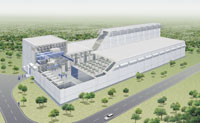Spent nuclear fuel contains unused fissionable uranium and newly produced plutonium. These substances can be collected, reprocessed, and reused as new fuel, to achieve effective utilization of energy resources.
This process of recycling uranium resources is referred to as the nuclear fuel cycle.
As a country that relies heavily on imports for most its energy needs, Japan is actively pursuing the establishment of the nuclear fuel cycle as a means for securing stable, long-term supplies of energy resources through the effective utilization of uranium, and for ensuring the proper treatment and disposal of radioactive waste.
In plutonium-thermal ("plu-thermal") power generation, plutonium is removed from spent fuel and mixed with uranium to produce MOX* fuels for use in existing nuclear power plants. This effective utilization of limited uranium resources is expected to contribute significantly to securing stable energy supply in the future.
To promote the introduction of plutonium-thermal power generation, electric power companies in Japan are making various efforts to obtain broad public acceptance of this new power generation method. At TEPCO, we have loaded MOX fuel into Unit 3 at the Fukushima Daiichi Nuclear Power Station in August 2010, and are steadily working our way toward the implementation of plutonium-thermal power generation.
* MOX
Mixed oxide composed of uranium and plutonium
Nuclear fuel cycle

Japan Nuclear Fuel Limited (JNFL) is operating a nuclear fuel cycle business in Rokkasho village of Aomori Prefecture. So far, a uranium enrichment plant, a low-level radioactive waste burial center, and a high-level radioactive waste storage and management center have begun operations. Today, test operations are being conducted at the reprocessing plant with the aim to commence operations in the near future, and its safety functions and equipment/facility performance are being checked carefully.
Japan Nuclear Fuel Limited (JNFL) : www.jnfl.co.jp/english/index.html
 JNFL's reprocessing plant (Rokkashomura, Aomori Prefecture)
JNFL's reprocessing plant (Rokkashomura, Aomori Prefecture)
Recyclable-Fuel Storage Company (RFS), a company founded by TEPCO and the Japan Atomic Power Company in Mutsu City, Aomori Prefecture, is currently preparing to construct an intermediate storage facility (recycled-fuel storage center).
Recyclable-Fuel Storage Company (RFS) : www.rfsco.co.jp (Japanese only)
 Rendering of the recycled-fuel storage center
(slated to commence operations in 2012)
Rendering of the recycled-fuel storage center
(slated to commence operations in 2012)
Reprocessing facilities produce fissionable products and other waste materials in the process of recovering uranium and plutonium from spent fuels. These waste materials are liquids that have high levels of radioactivity, and are therefore called high-level radioactive waste.
High-level radioactive waste is mixed with glass components and melted at high temperatures. The molten waste is then solidified into chemically stable, vitrified waste in an anti-corrosive stainless container. Because vitrified waste has high calorific value, it must be stored and cooled for about 30 to 50 years and ultimately buried in a stable stratum more than 300 meters below the earth's surface.
This underground disposal method is internationally acknowledged as a highly viable method that poses fewer problems compared to the cosmic, seabed, and ice-sheet disposal methods that have been researched by international institutions and countries around the world. So far, countries such as Finland, Sweden, and France have adopted the underground disposal method.
In Japan, the Nuclear Waste Management Organization of Japan (NUMO) was established to undertake the disposal of nuclear waste, based on the Law on Final Disposal of Designated Radioactive Waste (Final Disposal Law).
NUMO is presently seeking candidate sites for preliminary investigation on the feasibility of siting a final repository. After investigating the appropriateness of candidate sites in terms of basic geological conditions such as the absence of volcanoes or active faults, a site will be surveyed and selected through a three-step survey process.
In June 2007, the Final Disposal Law was revised, and low-exothermic radioactive waste with long half-lives (transuranic (TRU) waste)* was included among radioactive waste requiring underground disposal. In line with this revision, NUMO has expanded its operations to include the disposal of TRU waste in the same manner and schedule as high-level radioactive waste.
To ensure the proper disposal of radioactive waste, the government, NUMO, and electric power companies who bear a responsibility as generators of radioactive waste must fulfill their respective roles under a proper framework of role sharing and cooperation.
At TEPCO, we have enhanced our exhibitions on the underground disposal of high-level radioactive waste at our Electric Power Museum in Shibuya, Tokyo, and PR facilities at our nuclear power stations. We are also disseminating greater understanding of radioactive waste through various communications activities, and will continue these educational efforts.
* Low-exothermic radioactive waste with long half-lives (transuranic (TRU) waste)
TRU waste is low-level radioactive waste that contains nuclides with long half-lives exceeding a certain level. It is produced during the operations and dismantlement of reprocessing plants and MOX fuel fabrication plants. There is an estimated 18,100m3 of TRU waste that needs to be disposed of.
NUMO : www.numo.or.jp/en/index.html
Image of a high-level radioactive waste disposal system
 * The multi-layered barrier system encloses radioactive waste in many layers of barriers to isolate high-level radioactive waste safely away from our lives over a long period of time.
* The multi-layered barrier system encloses radioactive waste in many layers of barriers to isolate high-level radioactive waste safely away from our lives over a long period of time.
Schedule of underground disposal
 Source: Based on materials from the Nuclear Waste Management Organization of Japan (NUMO)
* At times, the government may consult with a municipality regarding the implementation of a literature-based survey, while giving full consideration to the wishes of the local community.
Source: Based on materials from the Nuclear Waste Management Organization of Japan (NUMO)
* At times, the government may consult with a municipality regarding the implementation of a literature-based survey, while giving full consideration to the wishes of the local community.
The head of the municipality may accept or reject the government's proposition.
Source: Based on materials from the Nuclear Waste Management Organization of Japan (NUMO)
© Tokyo Electric Power Company Holdings, Inc.